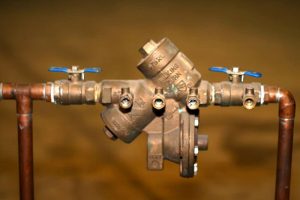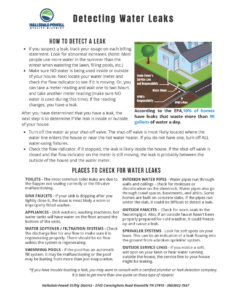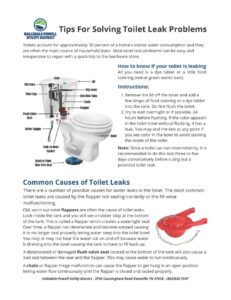
How to Detect Leaks
According to the Environmental Protection Agency (EPA), 10% of homes have leaks that waste more than 90 gallons of water a day. Toilets account for approximately 30% of a home’s indoor water consumption and they are often the main source of household leaks. Here are some tips for detecting water leaks and solving toilet leak issues.
Water Meter Tips
Click here to learn how to read your meter, how to use your meter to detect an issue, and how to understand your billing statement.
Lawn Irrigation Tips
Click here for tips on how to control water usage when irrigating your lawn.
Prevent Costly Frozen Pipes
Cold weather can wreak havoc on pipes. Repairing pipes and paying for the water that has leaked can be quite costly.
Simple steps you can take to prevent your pipes from freezing.
- Insulate pipes in unheated areas such as garages, attics, and crawls spaces.
- Open cabinet doors to allow heat to get to uninsulated pipes under sinks and appliances near exterior walls.
- Remove garden hoses and cover hose bibs to keep them from freezing.
- Locate your main water shut off valve and make sure it is working properly. Don’t wait for an emergency to locate it.
- Winterize your irrigation system by blowing it out or draining it.
If you leave a house for several days, take steps to prevent pipes from freezing.
- Turn off the main shut off valve.
- Leave your heat on at a minimum temperature setting to help keep the pipes from freezing in the interior walls.
- Open indoor and outdoor faucets to drain the pipes.
- Turn off the electricity or gas to the water heater.
- Have someone check on the house to make sure the heat is still on.
What if My Pipes Freeze?
- Do not take chances if you turn the faucets and nothing comes out, leave the faucets turned on and call a plumber. If you detect that your water pipes have frozen and burst, shut off the water at the main shut-off valve in the house, and leave the water faucets turned on. Make sure everyone in the family knows where the water shut-off valve is located and how to open and close it.
- Never try to thaw a pipe with a torch or an open flame. Water damage is preferable to fire damage. You may be able to thaw a frozen pipe with the warm air of a hair dryer. Start by warming the pipe as close to the faucet as possible working toward the coldest section of the pipe.
- Do not use electrical appliances in areas of standing water because you could be electrocuted.
Backflow & Cross-Connection Control
Backflow Preventers

Providing safe drinking water to our customers is our highest priority and we follow strict standards to ensure that the public drinking water is safe. Our customers also have a responsibility to help keep the public water supply safe whenever there is an actual or potential hazard for a cross connection.
What is a cross connection?
Cross connections are connections between drinking water and other water or fluids of unknown quality. A backflow preventer may be required if the potential for a cross-connection exists.
Where can I find possible cross connections?
- Sinks & laundry tubs
- Outside faucets & hoses
- Lawn irrigation systems
- Handheld shower sprayers
- Boilers
- Toilet fill valves
- Fire prevention systems
- Swimming pools
- Cooling systems
What is backflow and why are backflow preventers needed?
Backflow is the undesirable reversal of flow in a water line that is caused either by backpressure or backsiphonage. Backpressure can occur when downstream pressure is higher than the upstream or supply pressure. Backsiphonage can occur when negative pressure or a vacuum is created.
Backflow preventers are designed and installed to prevent the flow of water backwards through a pipe. These devices protect your public utility drinking water system from back flow created by backsiphonage and backpressure.
Who can install and test backflow preventers?
Installation—approved backflow prevention assemblies shall be installed by licensed plumbers and contractors. Testing and Inspection—only a person who is a certified tester registered with TDEC can inspect and/or test backflow prevention assemblies.
How often are backflow preventers tested?
For reduced pressure (RP) devices, they are test annually. For double-check devices, they are tested twice a year. Tennessee Code Annotated 68-221-701-720 requires that all Utility Districts ensure all backflow preventers are in proper working order and are tested annually by certified personnel.
How can I prevent contamination to my drinking water?
DON’T
- Submerge hoses in buckets, pools, tubs, sinks, ponds, etc.
- Use spray attachments without a backflow prevention device
- Connect waste pipes from water softeners or other treatment systems to the sewer, submerged drain pipe, etc.
- Use a hose to unplug blocked toilets, sewers, etc.
DO
- Keep the ends of hoses clear of all possible contaminants
- Install an approved backflow prevention assembly on all underground lawn irrigation systems.
- Leave an air gap, or space, between valves or faucets and any place water can collect.
What are my responsibilities?
If your water use introduces the potential for a cross-connection, you must:
- Have a backflow device installed by a licensed plumber or contractor. (HPUD will provide a list per request)
- Repair the device as needed. HPUD will have the device tested annually and after any repairs for a $45 fee. If you choose to have your device tested through another service, you must send passing results to HPUD to avoid water service termination. (HPUD will provide a list of certified testers.) If your device fails, you must have it repaired within 30 days of receiving a failure letter. An inspector from HPUD will then retest the device. If the device fails again you have 15 days to have it repaired or your water service will be terminated. Note: Water supply to the device must be on for testing.
For more information on the importance of backflow preventers and cross-connection control, watch this video from the American Backflow Prevention Association.


